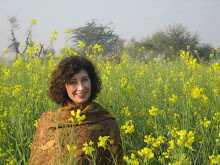
We had a white Christmas this year in Seattle. While the flakes were swirling down, we were in the kitchen up to our elbows in masa. A Mexican tradition, my friend Yolanda taught me how to make tamales when I lived in Southern California. We had some friends over and spent the day drinking margaritas, kneading masa (corn dough), making molé, and filling masa smeared ojas (corn husks) with spicy chicken, roasted poblano chilies and jack cheese. The recipe for fun and food is simple: Sip, spread, stuff, steam, and eat until you burst.
The masa has a pinch of chili powder in it. The mole has a healthy handful added. While purchasing the tamale ingredients, I bought some New Mexico chili powder at the Mexican Market in Pike Place Market. "It's hot," the proprietress assured me. Good. I like it spicy. But I couldn't resist mixing spices from countries and continents by throwing in a bit of Indian chili powder I bought during one of my visits to Rajasthan.
The smell of it brought back memories. I was on my way to see gharials at the Chambal River in Sawai Madhopur. The crocodile-like reptiles are endangered and I wanted to see them in the wild. To do that, I had to be on the road by 5am for the nearly two hour ride. Apparently gharials get up early. I was in an open air jeep and the late February air was chilly. Then it became very fragrant. And spicy smelling. Suddenly, I saw mounds and hills of red. I thought it was flowers.
As we got closer I saw massive piles of drying red chili peppers. The sun was rising, the gharials were probably waking up, but I made the driver stop. Women in colorful saris and dazzling smiles were squatting in the midst of it all sorting the peppers. Men stood by tractors sipping warm chai. I walked around the mass of chilies, took pictures and big whiffs.
I got back in the jeep. The chili pepper detour made us "late." There were a few long-snouted gharials in the river, but I think we missed the bulk of them. And while I won't forget seeing these incredible reptiles motionless on the riverbanks, neither will I forget sniffing the air, heavy with the scent of drying chilies.

When I got back to Jaipur I bought a big bag of chili powder at the bazaar. It was freshly sealed by a boy holding the plastic bag over a candle flame.












